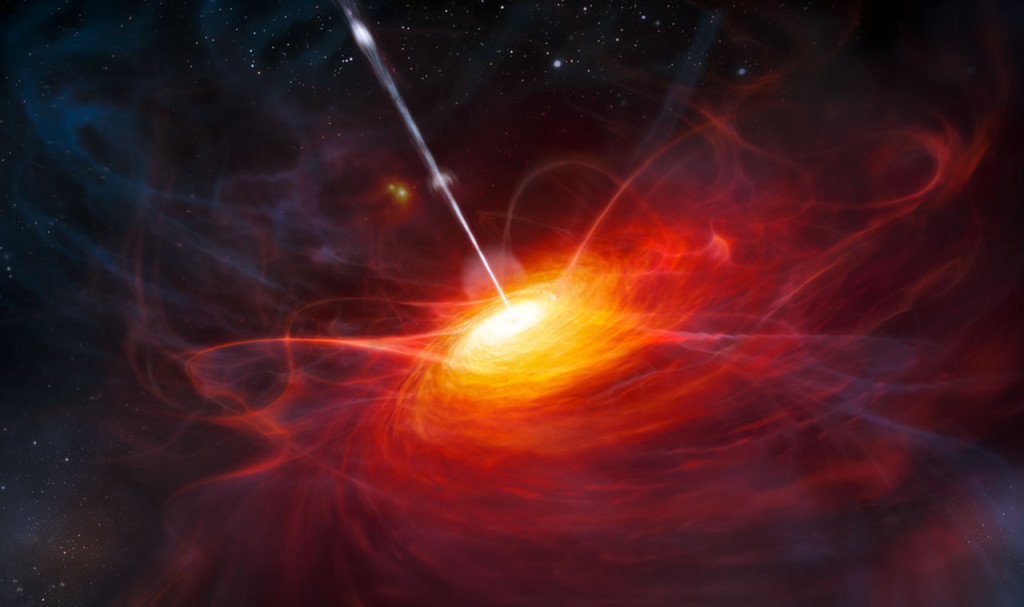Science Seen Physicist and Time One author Colin Gillespie helps you understand your world.
ULAS J1120+0641 : Voice from the Deep
For most people, what they hear or see speaks to the here and now. But for astronomers, a telescope looking at deep space captures a message from the past because it shows a picture that took time to travel at the speed of light. Thus they measure distances in light years – in other words, in terms of time. The further away in space their telescope sees, the further back in time it peers. But the further the source, the weaker its voice as heard from here – a hundred times weaker for each tenfold increment in distance.
So there was excitement when a group of astronomers detected a new and very distant voice. It is a short-wave radio broadcast. Its call sign is ULAS J1120+0641. Its voice bears messages from relatively soon after the dawn of time. Its broadcaster is a bizarre object, called a quasar, near the edge of the visible universe, powered by a huge black hole that converted vast amounts of matter into energy. Each second the quasar totally destroyed several Earth-masses just to get its broadcast out. This is like a trillion-trillion one-thousand-megaton hydrogen bombs, say one Mississippi, and then repeat. Sounds like science fiction but it’s not.
Around 770,000,000 years AB (after the beginning of the universe) or thirteen billion years ago, ULAS J1120+0641 was thirteen billion light years away. It can be dimly seen from here with fancy telescopes because it shone some sixty trillion times more brightly than our Sun now shines. The time frame gets confusing: We detect its broadcast now although the quasar burned out long ago. Astronomers are thrilled to find so bright a light from so far back in time. From its spectrum they deduce the state of the thin gas in space back then. As they hoped, it was mostly neutral hydrogen atoms, rather than the soup of protons and electrons that they turned into later. This is message one.
Message two seems to have slipped from view in the excitement. British astrophysicist Daniel Mortlock, lead author of a paper on the quasar, says:
These observations showed that the mass of the black hole at the centre of ULAS J1120+0641 is about two billion times that of the Sun. This very high mass is hard to explain so early on after the Big Bang. Current theories for the growth of supermassive black holes predict a slow build-up in mass as the compact object pulls in matter from its surroundings.
Mortlock calls this a headache. Caltech astronomer Richard Ellis is even blunter:
It’s almost impossible to understand how it could have formed in the limited time that the universe had up to that point.
Current physics assumes the entire mass of the universe began as an infinitely dense point―a so-called singularity. Approximately zero physicists believe this happened. So why do so many assume it? Well, it pops out of their math―namely, the equations of general relativity. The same physics says the ULAS J1120+0641 black hole could not grow so big so soon. But it did.
This kind of problem drives new physics. Or it should. The new physics that’s on offer lately is called cosmological inflation (more on this some other time). Problem is: It creates at least as many problems as it solves. So we need newer physics now―a truly quantum view of how the universe began.
Five years ago Carlo Rovelli, a leading commentator on new physics, said:
At small scales we might expect a “quantum spacetime” formed by “quanta of space” evolving probabilistically and allowing “quantum superposition of spaces”.
Maybe he’s right. I have a question for him.
Dr. Rovelli:
What would the quantum spacetime look like as time began? How many quanta of space would there be?
Coming: Is aversion for religion holding physics back?
Sources
Daniel Mortlock et al (2011), “A luminous quasar at a redshift of z=7.085”, Nature, London: Macmillan, vol. 474, p. 616; http://arxiv.org/pdf/1106.6088v1.pdf, see also http://www.eso.org/public/news/eso1122/
Michael Lemonick (2014), “The First Starlight”, Scientific American, April, p. 38; http://www.scientificamerican.com/article/first-stars-in-the-universe/, https://www.cfa.harvard.edu/~loeb/SA_14.pdf
Carlo Rovelli (2009), “Unfinished Revolution”, in Approaches to Quantum Gravity, Daniel Oriti (ed.), New York: Cambridge University Press, p. 5; http://arxiv.org/pdf/gr-qc/0604045.pdf
Other information:
Colin Gillespie (2013), “Time One”, in Time One: Discover How the Universe Began, New York: RosettaBooks, p. 284, http://www.rosettabooks.com/book/time-one/, excerpted at http://www.timeone.ca/chapters/time-one.pdf
ESO zooms in on ULAS J1120+0641, http://www.eso.org/public/videos/eso1122b/
ESO explains the discovery, http://www.youtube.com/watch?v=2R6UYYJXVr8


No comments yet.